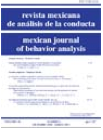EVIDENCE FOR A SPATIAL BlAS IN THE DISCRIMINATION LEARNING OF YOUNG CHILDREN
Main Article Content
Abstract
Developmental change in attention to spatial versus nonspatial dimensions of stimuli was studied in children and adolescents. Subjects were trained to select one of three different stimuli on a card and then tested with changed stimulus positions. Selecting a training stimulus indicated nonspatial attention; selecting a training position Indicated spatial attention. Experiment 1 found no spatial bias with shape, color, or picture stimuli in 6 children, 4~ to 6-years oid. Experiment 2 employed ~ wider range of ages, from 1 to 15 years, in 18 children and 3 adolescents, and a simplified procedure testing only shape stimuli. Thís experiment found a reliable spatial bias in yoUnger children (logistic, r~0.61 , p<0.00S>, andan estimated transition to shape bias at 2.75 years. The spatial bias in young children parallels that found in other species; findings are discussed in relation to failures to find symbolic stimulus relations in some inúividuals.
